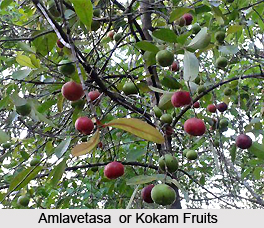 Amlavetasa, Indian medicinal plant has the properties of medicine and often serves as substitute for a medicine. This plant is scientifically named as Garcinia indica (Roxb.) Jessop. Amlavetasa is popular in different states in different names. This plant is known as `Kokam butter tree` or `Mangosteen oil tree` in English, `Kokan` in Gujarati, `Kokam` in Hindi, and `Dhupadamara` in Kannada. This plant is called by the name of `Birondi` by the people of Goa, `Amsol` or `Bhirand` is called by the people of Maharashtra and the people of Tamil Nadu know this plant by the name of `Murgal`.
Amlavetasa, Indian medicinal plant has the properties of medicine and often serves as substitute for a medicine. This plant is scientifically named as Garcinia indica (Roxb.) Jessop. Amlavetasa is popular in different states in different names. This plant is known as `Kokam butter tree` or `Mangosteen oil tree` in English, `Kokan` in Gujarati, `Kokam` in Hindi, and `Dhupadamara` in Kannada. This plant is called by the name of `Birondi` by the people of Goa, `Amsol` or `Bhirand` is called by the people of Maharashtra and the people of Tamil Nadu know this plant by the name of `Murgal`.
Amlavetasa is generally found in the evergreen forests of the Western Ghats. This plant is dispersed from southwestern Maharashtra to southern Karnataka, Kerala and western Tamilnadu. This plant is sometimes planted in southern Maharashtra and elsewhere in its native south Indian range as an oil producer.
Amlavetasa is a small, slender, evergreen tree with drooping or spreading branches. Leaves are obovate oblong or elliptic lanceolate, 6.3cm to 9cm long and 2.5cm to 3.8cm wide. The leaves are red in colour at the young stage and get dark green when they are a bit older. The upper surface of the leaves is dark green above and pale beneath, glabrous with entire, slightly undulating margins and the petioles are 0.6cm to 0.9cm long.
Flowers are axillary or terminal, solitary or in spreading fascicles. The pedicels are 4mm to 8mm long or sometime absent. The bracts are scale like, deciduous and the sepals are 4.5 mm long, decussate, thick and fleshy; outer smaller, oblong ovate, inner larger and obovate orbicular. The petals of the flower are four in number, thick and a little longer than the sepals. The male flowers remain in cluster of 3 to 8 flowers and the female flowers persist in 2 to 3 together. The edible fruit is globose or spherical, 2.5cm to 3.8cm in diameter, dark purple in colour when the time of ripening comes. The fruit enclose 5 to 8 large, compressed seeds embedded in a purple pulp. Flowers generally blossom from November to February and the time of ripening of fruits come in April to May.
Amlavetasa is considered to own immense medicinal properties and in medicinal practices the plant especially the fruit is of huge demand and of great value. According to the practitioners of Ayurveda the fruit is considered to have anthelmintic and cardiotonic properties and is also utilitarian for the treatment of piles, dysentery, tumours, pains and heart ailments. Syrup made from syrup the fruit of Amlavetasa is said to be a fabulous medicine to treat bilious disorders. The seeds also cater edible oil known commercially as Kokam butter, which is considered astringent, demulcent, emollient and soothing. It is used for ointments, suppositories and other pharmaceutical purposes. This is applied locally and is useful for promoting healing of chapped or cracked lips, hands and feet.



















